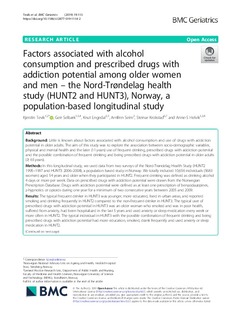| dc.contributor.author | Tevik, Kjerstin Elisabeth | |
| dc.contributor.author | Selbæk, Geir | |
| dc.contributor.author | Engedal, Knut | |
| dc.contributor.author | Seim, Arnfinn | |
| dc.contributor.author | Krokstad, Steinar | |
| dc.contributor.author | Helvik, Anne-Sofie | |
| dc.coverage.spatial | Norway | nb_NO |
| dc.date.accessioned | 2019-12-31T10:19:31Z | |
| dc.date.available | 2019-12-31T10:19:31Z | |
| dc.date.created | 2019-04-23T08:47:34Z | |
| dc.date.issued | 2019 | |
| dc.identifier.citation | Tevik, K., et al. (2019). "Factors associated with alcohol consumption and prescribed drugs with addiction potential among older women and men - the Nord-Trondelag health study (HUNT2 and HUNT3), Norway, a population-based longitudinal study." BMC Geriatr 19(1): 113. | nb_NO |
| dc.identifier.issn | 1471-2318 | |
| dc.identifier.uri | http://hdl.handle.net/11250/2634520 | |
| dc.description.abstract | BACKGROUND:
Little is known about factors associated with alcohol consumption and use of drugs with addiction potential in older adults. The aim of this study was to explore the association between socio-demographic variables, physical and mental health and the later (11 years) use of frequent drinking, prescribed drugs with addiction potential and the possible combination of frequent drinking and being prescribed drugs with addiction potential in older adults (≥ 65 years).
METHODS:
In this longitudinal study, we used data from two surveys of the Nord-Trøndelag Health Study (HUNT2 1995-1997 and HUNT3 2006-2008), a population based study in Norway. We totally included 10,656 individuals (5683 women) aged 54 years and older when they participated in HUNT2. Frequent drinking was defined as drinking alcohol 4 days or more per week. Data on prescribed drugs with addiction potential were drawn from the Norwegian Prescription Database. Drugs with addiction potential were defined as at least one prescription of benzodiazepines, z-hypnotics or opioids during one year for a minimum of two consecutive years between 2005 and 2009.
RESULTS:
The typical frequent drinker in HUNT3 was younger, more educated, lived in urban areas, and reported smoking and drinking frequently in HUNT2 compared to the non-frequent drinker in HUNT3. The typical user of prescribed drugs with addiction potential in HUNT3 was an older woman who smoked and was in poor health, suffered from anxiety, had been hospitalized in the last 5 years and used anxiety or sleep medication every week or more often in HUNT2. The typical individual in HUNT3 with the possible combination of frequent drinking and being prescribed drugs with addiction potential had more education, smoked, drank frequently and used anxiety or sleep medication in HUNT2.
CONCLUSION:
Individuals who were identified as frequent drinkers in HUNT2 were more likely to be frequent drinkers in HUNT3, and to have the possible combination of frequent drinking and being prescribed drugs with addiction potential in HUNT3. Health care professionals need to be aware of use of alcohol among older adults using drugs with addiction potential. | nb_NO |
| dc.description.sponsorship | This project has been made possible by the Norwegian Extra Foundation for Health and Rehabilitation (https://www.extrastiftelsen.no/) through the Norwegian Council for Mental Health (http://www.psykiskhelse.no/) (2015/ FO5044). In addition, the project has been funded partly by the Norwegian National Advisory Unit on Ageing and Health, Vestfold Hospital Trust (http:// www.aldringoghelse.no/). KT is a PhD fellow in this project and she received the funding. The funders had no role in the study design, data collection and analyses, decision to publish, or preparation of the manuscript | nb_NO |
| dc.language.iso | eng | nb_NO |
| dc.publisher | Springer Nature | nb_NO |
| dc.rights | Navngivelse 4.0 Internasjonal | * |
| dc.rights | Navngivelse 4.0 Internasjonal | * |
| dc.rights.uri | http://creativecommons.org/licenses/by/4.0/deed.no | * |
| dc.subject | Addictive drugs; Ageing; Alcohol; Drinkers; Drinking; Elderly; HUNT; Longitudinal study; Psychotropic drugs; Substance misuse | nb_NO |
| dc.title | Factors associated with alcohol consumption and prescribed drugs with addiction potential among older women and men – the Nord-Trøndelag health study (HUNT2 and HUNT3), Norway, a population-based longitudinal study | nb_NO |
| dc.type | Journal article | nb_NO |
| dc.type | Peer reviewed | nb_NO |
| dc.description.version | publishedVersion | nb_NO |
| dc.rights.holder | © The Author(s). 2019 Open Access This article is distributed under the terms of the Creative Commons Attribution 4.0 International License (http://creativecommons.org/licenses/by/4.0/), which permits unrestricted use, distribution, and reproduction in any medium, provided you give appropriate credit to the original author(s) and the source, provide a link to the Creative Commons license, and indicate if changes were made. The Creative Commons Public Domain Dedication waiver (http://creativecommons.org/publicdomain/zero/1.0/) applies to the data made available in this article, unless otherwise stated. | nb_NO |
| dc.source.pagenumber | 15 | nb_NO |
| dc.source.volume | 19 | nb_NO |
| dc.source.journal | BMC Geriatrics | nb_NO |
| dc.source.issue | 1 | nb_NO |
| dc.identifier.doi | 10.1186/s12877-019-1114-2 | |
| dc.identifier.cristin | 1693342 | |
| cristin.unitcode | 1991,0,0,0 | |
| cristin.unitname | Sykehuset Innlandet HF | |
| cristin.ispublished | true | |
| cristin.fulltext | original | |
| cristin.qualitycode | 1 | |

